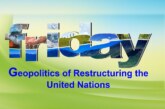
*Dr. Arvind Kumar

By 2050 the number of people living in cities will have nearly doubled, from 3.6 billion in 2011 to more than 6 billion. Yet the world’s urban areas are already overcrowded and, particularly in developing countries, who suffer from shortages of clean water, electricity, and other resources essential to the support of their exploding populations and fragile economies. At the same time, cities are a key contributor to climate change, as urban activities are major sources of greenhouse gas emissions. Estimates suggest that cities are responsible for 75 percent of global CO2 emissions, with transport and buildings being among the largest contributors. The idea that climate change is everyone’s problem is only partially accurate. While inevitably consequences are felt by all, its causes are mainly driven by a handful of countries and industry sectors, with disproportionately negative impacts on vulnerable populations.
South Asia’s rapid growth in recent decades has lifted hundreds of millions out of extreme poverty, but according to Asian Development Bank (ADB) the region remains home to two-thirds of the world’s poor, with 33.4% South Asians still living on less than $2 a day. Poverty reduction remains a daunting task.
One of the most visible side-effects of South Asia’s rapid growth has been environmental damage. The reliance on fossil fuels has degraded air quality and eco-systems, reduced the supply of clean water, and created significant health hazards. The region has become the world’s largest source of greenhouse gas emissions, which are linked to global warming and climate change. Its cities are amongst the most polluted and the most vulnerable to extreme weather events. Recent climate-related disasters in India, Bangladesh and Pakistan are a reminder that South Asian policymakers must act now to protect their citizens and mitigate and reverse the signs of climate change to secure sustainable growth for the future.
In a rapidly urbanizing India the number of inhabitants in Indian cities is estimated to have increased almost fourfold between 1970 and 2020, from 109 million to 460 million. Already the second-largest urban community in the world, the country is expected to add another 416 million people to its cities by 2050 and have an urban share of population of 50 percent.
In India, many metropolitan cities like Delhi, Mumbai, Bengaluru are suffering from the problem of overcrowding which also leads to the problem of unemployment; according to National Statistical Office (NSO), India’s unemployment rate was 9.3% in urban areas in 2021.
According to the World Bank, the population living in slums in India was reported at 35.2 % of the total urban population in 2018 where the majorities of them are in substandard housing, overcrowding, and lack of electrification, sanitation, ventilation, roads, and drinking water facilities and generally build on underdeveloped or undervalued land. Due to such great demands, destruction of forests and agricultural land for the construction of buildings and factories degrades the land quality, leads to a larger carbon footprint, more consumption of resources and more demands for energy- a chain of feedback loops is produced by modern assumptions of a good quality of urban life.
The health conditions of urban poor people in some areas are more adverse diagnosing with diseases like allergies, asthma, infertility, food poisoning, cardiovascular complications, respiratory failure, cancer, and death. Mountains of garbage outside the city area have become the hallmark of any metropolitan city in India; in addition to it the existing landfills are full to the brim that they cannot accommodate more trash, this subjects the people living in such areas to multiple health risks like dysentery, malaria, plague, jaundice, diarrhoea, typhoid,etc.
At COP26 UN climate talks in Glasgow last year, the World Economic Forum’s “Net Zero Carbon Cities Initiative” set out more than 200 solutions that have the potential to rapidly turn this situation around. The Toolbox of Solutions for Urban Transformations, in this beta version, brings together real-life examples from 110 cities around the world pioneering solutions to decarbonize their cities while, for example, catalyzing growth in green jobs and improved air quality.
Therefore, building sustainable cities is among the most important aspects of a city’s life here on. Our core concepts need rethinking towards being sustainable and inclusive. We need to support more mixed traffic, mixed housing, walkable areas, etc. in short diversity is key — endowed enclaves don’t represent sustainability.
At COP27 in Egypt we need to embrace the positive vision not of energy transition but of sustainable growth and development. Sheer dismal litany of humanity’s failure to tackle such issues needs to be corrected. We have been focusing a lot on why, now it’s time to really focus on how. It is time for the ones who are causing the most harm to settle their bills and use the power they acquired to the detriment of the world’s environmental wellbeing to reset our planet.
It is now or never!
*President, India Water Foundation



